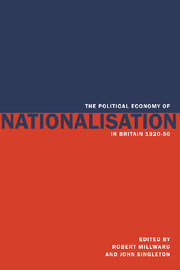Book contents
- Frontmatter
- Contents
- List of tables
- List of contributors
- Preface
- I Government and industry 1920–50
- 1 Industrial organisation and economic factors in nationalisation
- 2 Labour, the Conservatives and nationalisation
- II Case studies of industry organisation, performance and nationalisation
- III Government and the process of industrial change in the 1940s
- IV Review and Conclusions
- Index
1 - Industrial organisation and economic factors in nationalisation
Published online by Cambridge University Press: 07 May 2010
- Frontmatter
- Contents
- List of tables
- List of contributors
- Preface
- I Government and industry 1920–50
- 1 Industrial organisation and economic factors in nationalisation
- 2 Labour, the Conservatives and nationalisation
- II Case studies of industry organisation, performance and nationalisation
- III Government and the process of industrial change in the 1940s
- IV Review and Conclusions
- Index
Summary
The changes in the ownership of British industry in the 1940s were quite remarkable. Only fifty years before, at the end of the old century, the British government's disinclination to intervene in industrial matters was renowned. By the end of the 1940s government regulation and ownership of industry matched any country in the Western World. Nationalisation of transport and fuel by the 1945–51 Labour government was a major element in these changes: coal, railways, docks, inland waterways, road transport, gas, electricity, airlines, telecommunications, the Bank of England, iron and steel were all taken into public ownership. Only Supple (1986), Hannah (1979) and Edgerton (1984) have really tried to explain the reasons for this. The mainstream textbook explanations have involved two arguments (Aldcroft 1968, 1986, Alford 1988, Cairncross 1985). The first is that nationalisation was an inevitable outcome of long-standing problems especially in the ailing coal and railway industries. This however raises questions about why non-ailing industries like electricity, telecommunications and airlines were nationalised and why some ailing industries like cotton and shipbuilding were not. Why moreover was nationalisation the chosen form of public intervention for long-standing problems – what was inevitable about that? The second argument has been that the Labour government's nationalisations of the 1940s were the centrepiece of the socialist vision; they crystallised all that had been discussed and promised in the rise of socialism in the twentieth century. This raises the question of why socialism should have very restricted industrial boundaries with most of manufacturing left in private ownership.
These questions are addressed in this book and take on added significance from subsequent industrial developments in the UK including the 1980s privatisations.
- Type
- Chapter
- Information
- Publisher: Cambridge University PressPrint publication year: 1995
- 3
- Cited by



